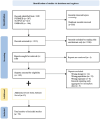Histoplasmosis in patients living with HIV in Europe: review of literature
- PMID: 38993488
- PMCID: PMC11238259
- DOI: 10.3389/fmicb.2024.1418530
Histoplasmosis in patients living with HIV in Europe: review of literature
Abstract
Histoplasma capsulatum (var. capsulatum Hcc and duboisii Hcd), is a dimorphic fungus that causes histoplasmosis. It usually affects people coming from endemic areas, causing a variety of clinical manifestations up to progressive disseminated histoplasmosis (PDH), especially among people living with HIV (PLWH). We conducted a systematic review to assess histoplasmosis burden of PLWH in Europe. The review follows PRISMA guidelines, with protocol registered in PROSPERO (CRD42023429779). Seventy-eight articles were selected, including 109 patients (32 women). On overall, median age was 37 years. Forty-six patients were Americans, 39 Africans, 17 Europeans, 5 Asians, in 2 cases nationality was not specified. Cases were mainly diagnosed in Italy (28.4%), France (17.3%) and Spain (17.4%), with a north-south gradient. Six cases lacked epidemiologic links with endemic areas. Concerning CDC HIV staging at diagnosis, the information was available for 60 PLWH (55%) and all subjects were at stage C3 except for two subjects at stage B3. PDH was the AIDS-presenting illness in 39 patients. Most patients had a PDH (80.7%); other common extrapulmonary forms were isolated cutaneous histoplasmosis (7.3%), or lymphatic localization (2.7%). In 30 cases, the diagnosis was made by analyzing only one sample. For the remaining 79 cases, multiple samples were collected from each patient. Regarding the biological sample more frequently used for the diagnosis of histoplasmosis, bronchoalveolar lavage sample was taken from 39 patients, and tested positive in 51.3% of cases; 36 patients underwent a skin biopsy which was positive in 86.1% of cases and 28 patients performed bone-marrow biopsy, which led to the diagnosis of histoplasmosis in 92.9% of cases. The identification of Histoplasma capsulatum was available in 97 PLWH through examination of different samples: Hcc and Hcd were identified in 89 and 8 PLWH, respectively. Concerning therapies, 67.9% were treated with liposomal amphotericin B, 18.3% with itraconazole, 10 died pre-treatment. The overall mortality rate was 23.6%. Non-survivors exhibited more frequently gastrointestinal symptoms (p = 0.017), while cutaneous signs correlated with better survival (p = 0.05). Untreated patients faced higher mortality (p < 0.001). Histoplasmosis should be considered amongst opportunistic infection in PLWH, even in Europe, especially if patients originate from or have travelled to endemic areas. Systematic review registration: The registration number is CRD42023429779.
Keywords: acquired immunodeficiency syndrome; dimorphic fungal pathogens; endemic; histoplasma; progressive disseminated histoplasmosis.
Copyright © 2024 Kontogiannis, Di Lorenzo, Zaçe, Benvenuto, Moccione, Muratore, Giacalone, Montagnari, Carnevale, Mulas, Coppola, Campogiani, Sarmati and Iannetta.
Conflict of interest statement
The authors declare that the research was conducted in the absence of any commercial or financial relationships that could be construed as a potential conflict of interest. LS declared that she was an editorial board member of Frontiers, at the time of submission. This had no impact on the peer review process and the final decision.
Figures




References
-
- Amadori F., Doria R., Gemignani G., Flammini S., Leonildi A., Ciancia E. M., et al. . (2015). Histoplasmosis: the multiple sides of an uncommon disease. Infez. Med. 23, 61–68, PMID: - PubMed
-
- Angius A. G., Viviani M. A., Muratori S., Cusini M., Brignolo L., Alessi E. (1998). Disseminated histoplasmosis presenting with cutaneous lesions in a patient with acquired immunodeficiency syndrome. J. Eur. Acad. Dermatol. Venereol. 10, 182–185. doi: 10.1016/S0926-9959(98)00003-8, PMID: - DOI - PubMed
Publication types
LinkOut - more resources
Full Text Sources
Miscellaneous

